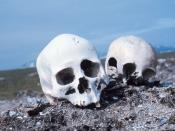It has been approximately twenty months since 2001s September 11th terrorist attacks on the World Trade Center, and still victims' bodies are in the process of being identified. In matters like this, forensic scientists are forced to "bring out the big guns." Researchers can compare DNA samples from bodies to those taken directly from the victim: from hair, a toothbrush, a family member, and etcetera (Whitfield 6).
As a result of the terrorist attacks, forensic scientists have come up with innovative tests and ways to interpret the resulting identification data (Whitfield 1). According to forensic DNA expert John Butler (National Institute of Standards and Technology in the city of Gathersburg, Maryland), "The techniques developed for the World Trade Center will benefit the whole field" (Whitfield 2).
According to New York's chief forensic biologist, Robert Shaler, about ten new victims of the 9/11 terrorist attacks are being identified each month with DNA forensics.
He predicts that the project will be finished in about a year's time, when all of the latest tests have been run (Whitfield P16).
At Ohio University, a new DNA analysis technique that is in its development stages may help authorities identify the remains of 9/11 victims (Gibson P1). The United States Department of Justice has given scientist Bruce McCord, a former Federal Bureau of Investigation scientist, a grant of $453,000 to develop a set of new DNA markers for damaged human remains that cannot be identified with the United States government's current protocol for deaths and missing people cases (Gibson P2)
Thanks to DNA evidence/forensic science, 1,484 (out of 2,795 presumably dead) victims have been identified (Whitfield P3). Thousands of families were affected by the tragedy of September 11, 2001, and now DNA fingerprinting is reconnecting many of those family members.
Sources:
www.nature.com/nsu/030421/030421-2.html
www.ohiou.edu/researchnews/science/mccord_DNA.html


